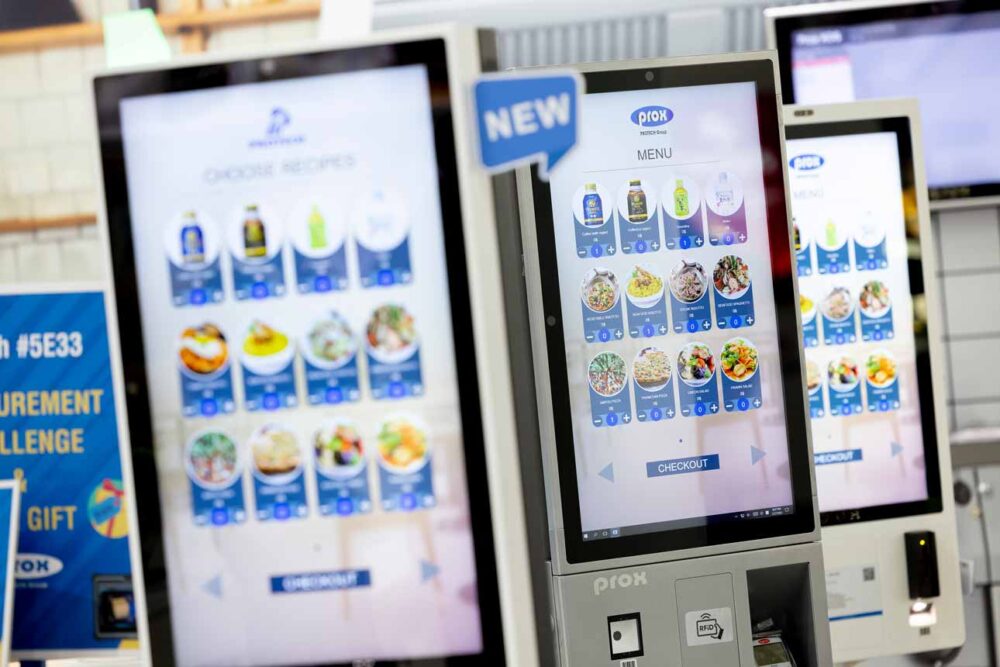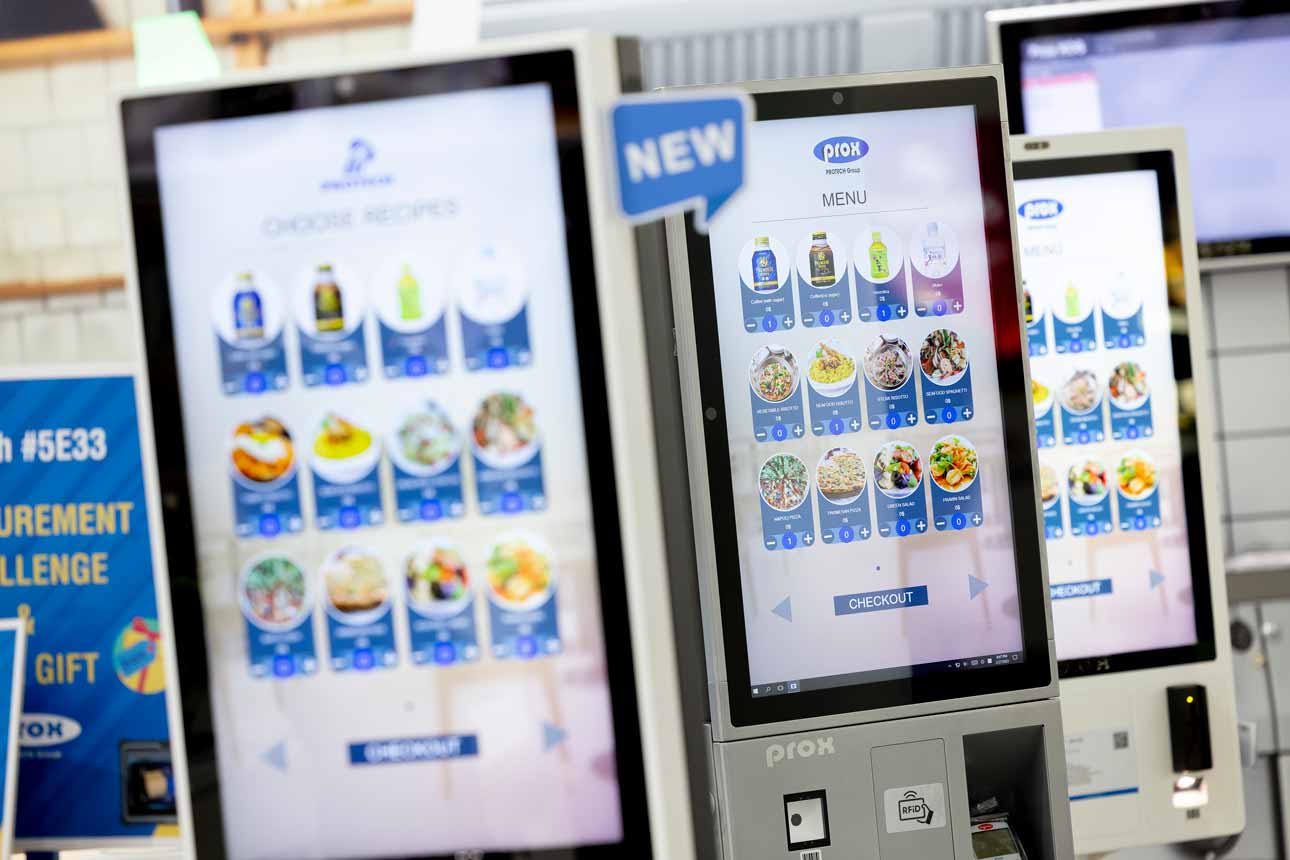Be it shoppers paying by Scan & Go, self-checkout, in checkout-free stores or via Click & Collect: offline retail is becoming increasingly digital. This requires suitable payment solutions – turning payment into a strategic success factor.
Flashback to 1994: databases and ERP systems, first commercial websites, mobile phones with colour displays, CD-ROMs, Java as a programming language or the new Windows 95 operating system with a GUI were all highly topical technologies that also kept the companies at EuroCIS busy. Payment systems were of rather subordinate importance as a trade fair topic because payment in retail was mostly still analogue. Cash, cheques and invoices accounted for together 95% of turnover. Credit card payments were done via Imprinter and a paper receipt. The first electronic payment options via EC card and signature (ELV) or by entering a pin code (ec-cash) back then together made up just under 2.5%.

Flash-forward to EuroCIS 2024: Digital payment solutions are among the hot topics in 2024. In the wake of on-going digitalisation retail companies have to cope with an extremely dynamic and increasingly international payment landscape today. Not only is 60% of turnover in offline retail now accounted for by card-assisted payment systems, but the diversity of digital payment methods has also markedly increased.
One in two shoppers pay by smartphone
Classic payment by card, where a card is introduced into the terminal or the transaction needs to be authorised by signature, are an exception rather than the rule these days. According to the study on payment methods in retail carried out by the EHI Institute in Cologne/Germany, contactless payment by card and NFC are now considered the “new normal”. And mobile payment by smartphone is also picking up. According to the EHI payment study, the percentage of smartphone-based payments has almost doubled in as little as one year amounting to over 5% of all card payments already in late 2022. Many of the retail companies polled by EHI now consider mobile payment one of the most relevant payment methods for the coming five years. This is also confirmed by current consumer surveys. According to Bitkom, over one in two Germans has paid by smartphone or Smartwatch over the past few months; this percentage is even as high as 84% among the under 30s.
Mobile options are growing
Underlying these figures is a wide variety of different methods. At present, they range from mobile payment using international Wallets such as Apple Pay or Google Pay and the mobile payment solutions offered by German municipal savings banks and cooperative banks through to optical methods (independent of banks) such as Bluecode, Payback Pay or the Chinese payment Apps Alipay and Wechat-Pay. The solutions are based on QR or barcodes and therefore operate independently of the mobile operating system or shoppers’ bank details. Topics such as the digital Euro or the European Wallet “wero” announced for 2024 are likely to add further dynamism here. The “wero” comes care of the European Payment Initiative EPI, an alliance of 16 European financial service providers including Deutsche Bank and Sparkassen-Finanzgruppe. This solution allows users to make real-time payments via smartphone in the Eurozone and it passed its first practical test in December 2023.
New processes at the POS
This new range of options opens up new avenues for offline retail – making payment solutions a strategic success factor at the same time. “Tomorrow’s payment is so much more than just paying,” says Markus Solmsdorff, Head of Strategy at VR Payment. The check-out as the traditional pain point in the customer journey will be re-invented, says Solmsdorff. What is in demand, he adds, are payment solutions that automate processes, make the Point of Sale more mobile and create added value for shoppers, such as time-saving self-service and unattended retail concepts, smart vending options, mobile check-out in store right with the shopper or mobile ordering in the showroom. The payment solutions provider for the Volksbanken Raiffeisenbanken has regularly presented innovative concepts for checkout-less stores over the past few years and has implemented self-checkout projects for German premier league football clubs such as Eintracht Frankfurt and Borussia Dortmund, to name but two clubs.
Carola Wahl also views the matching payment mix as a key building block for the modern customer journey. “Consumers have become accustomed to seamlessly changing from one sales channel to the next,” says Wahl, who heads business in the D-A-C-H region at European payment service provider Nexi. Whether they are checking prices, product ratings or product alternatives by smartphone while at the shelf, collecting goods ordered or reserved by Click & Collect in the store, or wishing to return goods: “Digital payment solutions pay a key role in the implementation of omnichannel strategies,” says Wahl. Adyen also sees considerable sales potential in omnichannel for companies. The increasing dovetailing of the online and offline worlds is likely to help online payment methods like Paypal or Amazon Pay make more inroads at the POS and increase the number of relevant payment options even further.
All-rounders with Android
This presents companies with challenges because in addition to the varied application options and user’s altered expectations, they also have to keep an eye on the costs of integration, implementation and use of a constantly rising number of payment methods. In this process they benefit from versatile and flexibly expandable card readers. Not least in view of greater investment security, equipment manufacturers such as Ingenico, Verifone and CCV are registering a growing demand for mobile, Android-based terminals. “Android has clearly become the most relevant operating system whose demand curve has been rising steeply since its introduction,” says Christine Bauer, Vice President International Sales at CCV Deutschland in Munich. Their asset: Android terminals can flexibly be extended to include new business functionalities with matching Apps. Equipped with printer, scanner and long-lasting batteries, Bauer adds, mobile terminals are true “allrounders” also potentially contributing to greater efficiency and leaner processes.
Safe AND convenient
Biometric processes such as face recognition or fingerprint scans and the integration of AI-controlled safety protocols for fraud prevention will in future contribute to further reducing friction losses in payment transactions and further optimising the checkout process for all parties involved, believes Peter O’Halloran, responsible for the European business of the international payment service provider Fiserv. In Germany this company operates under the Telecash brand.
One thing is certain: digital payment methods enable innovative added value such as automatic points collection, personalised payment offers or shopping without queues and shop closing times. Nevertheless, cash will not vanish from the POS in the medium term, as it allows customers to shop anonymously without data traces or the risk of fraud and requires neither an account nor a credit card. According to a recent study by Glory, cash and card payments remain almost equally popular with customers. In a representative survey, the international cash management specialist asked customers from Germany, Austria and Switzerland about their payment preferences. In addition to increased price awareness, the Glory Payment Report reveals, among other things, a desire for more freedom of choice – not only in terms of payment methods, but also in terms of flexibly choosing between serviced and self-service shopping. The authors’ conclusion: Enabling flexibility is becoming a central task at the POS.
EuroCIS 2024 offers a good opportunity to get an up-to-date overview of the range of retail-relevant AI and checkout offerings for autonomous stores. The trade fair for retail technology will take place in Halls 9 and 10 of the Düsseldorf exhibition grounds and is open to trade visitors from Tuesday, 27 February to Thursday, 29 February 2024, daily from 10 am to 6 pm. Online, the day ticket costs 28 euros and the two-day ticket 39 euros. Tickets and further information are available at: www.eurocis-tradefair.com.
















